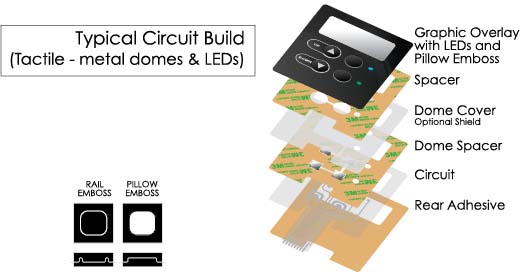Membrane Switch: Reliable, Cost-Effective, and User-Friendly Control Systems
Membrane Switch: Reliable, Cost-Effective, and User-Friendly Control Systems
Blog Article
Recognizing Membrane Changes: The Key to Long Lasting and Dependable Controls

What Are Membrane Layer Buttons?
Membrane switches are a sophisticated option in the world of interface modern technology, combining performance and style flawlessly. These tools work as an interface between users and electronic systems, integrating several elements right into a compact format. Generally built from flexible, thin layers of materials, membrane layer buttons are made to reply to touch, enabling users to connect with machinery and electronic devices effectively.
The primary elements of a membrane layer switch include a printed circuit layer, visuals overlay, and a spacer layer that protects against unplanned activation. The visuals overlay can be tailored to reflect brand name identification or customer choices, improving aesthetics while ensuring usability. Membrane buttons are frequently used in different applications, including clinical tools, customer electronics, and industrial tools, owing to their longevity and resistance to ecological factors such as dampness and dirt.
One of the key benefits of membrane switches is their capacity to hold up against deterioration, making them optimal for high-traffic environments. In addition, they are light-weight and need minimal room, permitting innovative layouts in product development. Generally, membrane layer switches stand for a effective and useful selection for contemporary digital interfaces, weding innovation with user-centric layout principles.
Just How Membrane Switches Over Work
The procedure of membrane layer switches hinges on a basic yet effective system that converts user input into electronic signals. When an individual presses the switch, the leading layer deforms, permitting a conductive element in the circuit layer to make call with an equivalent conductive pad on the underside of the graphic overlay.
The layout of membrane switches can vary, but they often integrate domes or tactile aspects to give responses to the individual, boosting the overall experience - membrane switch. The materials used in membrane switches, such as polyester or polycarbonate, contribute to their resilience and resistance to ecological aspects, consisting of dampness and dirt. The published circuits are commonly enveloped, which safeguards them from wear and tear over time.
Advantages of Membrane Layer Buttons

Furthermore, membrane layer buttons are recognized for their resilience. Built from durable products, they are immune to dirt, dampness, and physical wear, which substantially hop over to these guys expands their life-span contrasted to typical mechanical buttons. This durability makes them particularly ideal for high-traffic atmospheres and applications needing durability.
One more significant benefit is the ease of cleaning and maintenance. The smooth surface of membrane layer switches over decreases dirt buildup and is usually invulnerable to spills, making them suitable for settings that need frequent sanitization.
Moreover, membrane layer buttons offer a streamlined account, bring about a thinner layout that can be integrated into various tools without adding mass. This function not only improves the aesthetic allure however also contributes to a more ergonomic product design.
Applications of Membrane Buttons
Easy to use and flexible, membrane buttons discover applications across a vast array of industries, consisting of medical devices, customer electronics, and commercial devices. In the medical area, these switches are indispensable to gadgets such as analysis equipment, person tracking systems, and infusion pumps, where integrity and ease of cleansing are vital. Their ability to hold up against severe settings and preserve functionality makes them suitable for such applications.

In customer electronics, membrane layer buttons are used in items like microwaves, cleaning devices, and remotes - membrane switch. Their sleek style permits for intuitive interface, boosting the total user experience while supplying durability and resistance to use and tear
Commercial equipment likewise gains from membrane layer buttons, particularly useful site in control panels for machinery and automation systems. These buttons supply defense against dust and wetness, making certain consistent performance in difficult Visit Website atmospheres. Their customizable features enable producers to tailor them to particular operational requirements, improving effectiveness and performance.
Selecting the Right Membrane Change
When choosing a membrane switch, it is necessary to consider various factors that affect efficiency and viability for certain applications. The main considerations include environmental problems, responsive comments, resilience, and design specifications.
First, analyze the operating setting; buttons subjected to moisture, chemicals, or severe temperatures need details materials to ensure long life and capability. Next, evaluate the demand for responsive comments. Depending on customer interaction, some applications may profit from a tactile response to confirm activation, while others may prefer a non-tactile layout for aesthetic factors.
Longevity is one more crucial factor; membrane layer switches must be developed to withstand constant use, influences, and abrasion. Guarantee the picked switch can sustain the expected lifecycle, specifically in high-usage situations.

Conclusion
To conclude, membrane layer changes serve as crucial parts in the style of durable and trusted control systems across numerous markets. Their compact style, combined with durable construction and personalized functions, enhances individual interaction while making sure longevity sought after environments. The convenience of membrane switches over enables for customized services that fulfill particular functional needs, strengthening their significance in contemporary innovation. As industries proceed to evolve, the value of integrating efficient membrane layer switch options can not be overemphasized.
Membrane layer switches over stand for a crucial element of contemporary user interface style, mixing capability with strength in various applications.Membrane switches are a sophisticated solution in the world of customer interface modern technology, integrating capability and design seamlessly. Normally created from flexible, thin layers of products, membrane switches are made to react to touch, enabling customers to connect with equipment and electronic devices successfully.
The design of membrane layer switches can differ, however they often integrate domes or responsive aspects to offer responses to the user, boosting the overall experience.In conclusion, membrane changes serve as crucial parts in the style of trustworthy and resilient control systems across various sectors.
Report this page